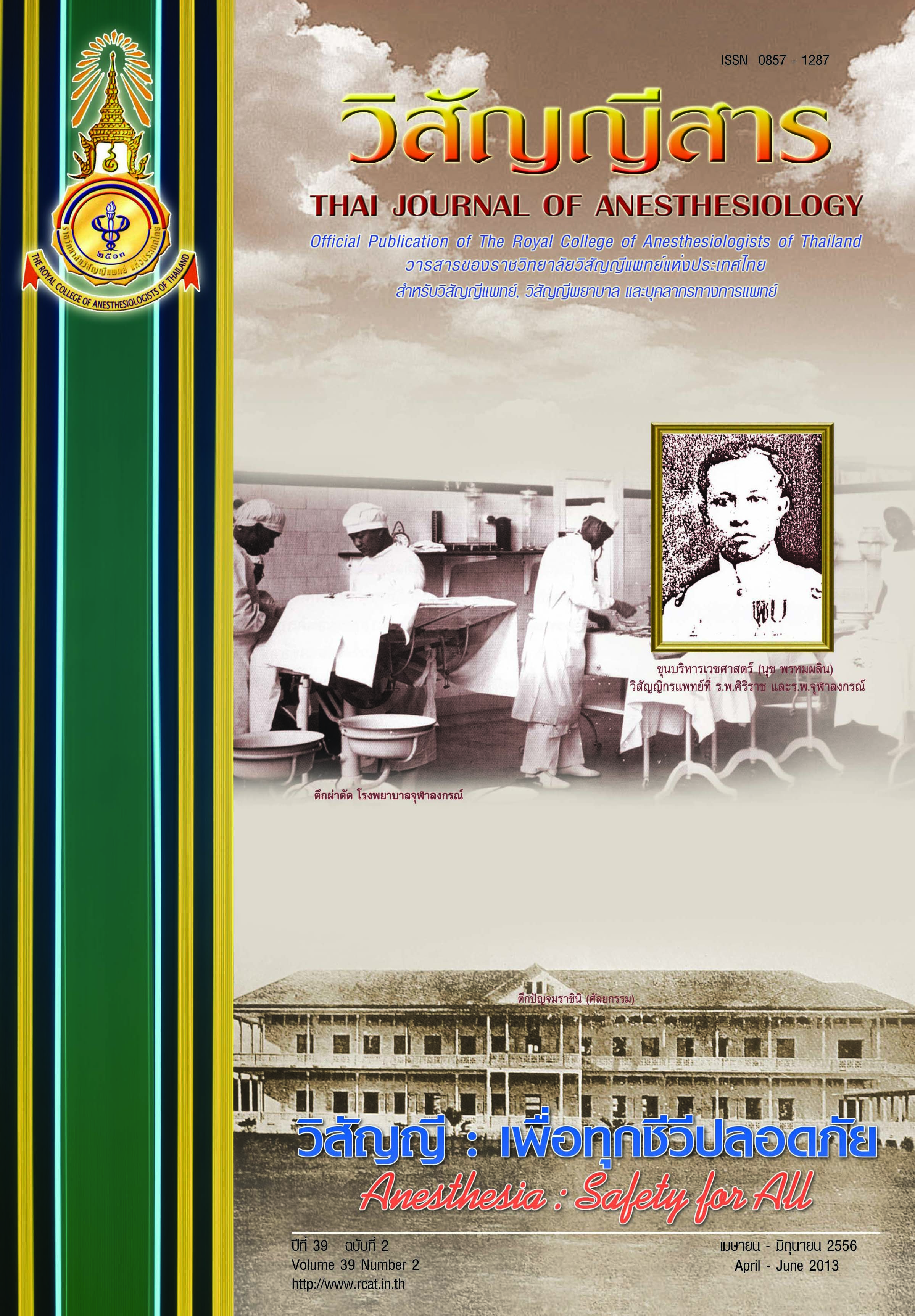The Management of LMA and i-gel in a Large Medical Center
Main Article Content
Abstract
Background: The reusable supraglottic airway devices, LMAs, in particular, are gaining popularity over decades. Managing these devices to achieve standards defined by manufacturer and preserving the device intregrity has been challenging, especially, in a large hospital. The common problems encountered are i.e. device losses, damages and paucity.
Objective: To survey and report the current usage, the availabilty, rate of loss and damages. Identify the problem areas and find solutions to cope with current situation.
Method: Survey the existing quantity and conditions of each devices, implement workflow to keep track of the devices. Analyze data and report the related information. Encourage staff members to help take care of devices.
Result: Prior to 2011, the exact quantity of supraglottic devices at Siriraj was not known. The acquisition of devices was on demand basis and there was no record regarding device checking in and out. The projected rate of loss before 2011 was 40 devices per year. After implementing the new workflow, the rate of loss has reduced to 16 devices per year. There has been improvements in many areas but there are also some problems that are yet to be resolved which will be planned within the next phase.
Conclusion: Taking good care and managing reusable supraglottic airway devices in a large hospital is possible. However, this consumes time and money, requires good team effort, workflow and collaboration. Further study is mandatory to compare between disposable or reusable overall cost-utility.
การควบคุมดูแลอุปกรณ์ช่วยหายใจเหนือกล่องเสียงชนิด LMA และ i-gel ในโรงพยาบาลขนาดใหญ่
บทนำ: การใช้อุปกรณ์ช่วยหายใจเหนือกล่องเสียงได้รับความนิยมเพิ่มขึ้นในช่วงหลายทศวรรษที่ ผ่านมา การบริหารจัดการควบคุมสต็อกในโรงพยาบาลขนาดใหญ่เป็นเรื่องท้าทายอย่างมาก ปัญหาที่พบบ่อย ได้แก่ การหาย การชำรุด และความขนาดแคลนของอุปกรณ์
วัตถุประสงค์: เพื่อทำการสำรวจอุปกรณ์ที่มีอยู่ และประเมินจำนวนความต้องการของอุปกรณ์ในแต่ละวัน ตรวจสอบอัตราการสูญหายและเสียหาย ศึกษา ปัญหาและประชุมหารือแนวทางเพื่อปรับเปลี่ยนวิธีการทำงานเพื่อแก้ไขปัญหา
วิธีการศึกษา: ตรวจนับ จำนวนชิ้นอุปกรณ์ที่มีอยู่ปัจจุบันและสำรวจสภาพ ปรับเปลี่ยนวิธีการเบิกจ่ายอุปกรณ์ การควบคุมสต๊อก จน บันทึกอัตราการยืม การจ่ายอุปกรณ์ อัตราการสูญหายและเสียหาย วิเคราะห์ข้อมูลและเสนอแนวทางการดูแล เพื่อแก้ไขปัญหา ให้สมาชิกในหน่วยงานมีส่วนร่วมในการช่วยกันดูแลรักษาอุปกรณ์
ผลการศึกษา: ก่อนปี 2554 จำนวนอุปกรณ์ LMA ในโรงพยาบาลศิริราชไม่ปรากฎแน่ชัด จากการสำรวจช่วง 2 เดือนพบว่าอัตราการ หายเทียบเท่ากับ 40 ชิ้นต่อปีสำหรับวิธีการควบคุมแบบเดิม อุปกรณ์ค่อนข้างขาดแคลน เมื่อปรับเปลี่ยนการ ควบคุมดูแลโดยติดตาม LMA อย่างใกล้ชิดโดยบันทึกรหัสประจำชิ้น พบว่าอัตราการสูญหายลดลงเหลือ 16 ชิ้นต่อปี อย่างไรก็ตาม ยังคงมีปัญหาอีกหลาย ๆ ด้าน เช่น อัตราการชำรุดและการเสื่อมของอุปกรณ์ ขาด ความรัดกุมในการควบคุม และความเสียหายของอุปกรณ์ที่เกี่ยวข้องโดยตรงกับผู้ใช้ส่วนใหญ่ที่เป็นผู้ฝึกหัด
สรุป: การควบคุมดูแลอุปกรณ์ช่วยหายใจชนิดใช้ซ้ำทั้ง 2 ประเภท (LMA, i-gel) สามารถทำได้แม้จะเป็น โรงพยาบาลขนาดใหญ่ แต่ก็ต้องใช้บุคลากรและงบประมาณส่วนหนึ่ง รวมถึง ระบบการควบคุมที่ดี และ ความร่วมมือจากคนในหน่วยงาน การเปรียบเทียบถึงความคุ้มค่าระหว่างการใช้อุปกรณ์ใช้ซ้ำได้หรืออุปกรณ์ ใช้ครั้งเดียวทิ้งยังต้องการข้อมูลศึกษาเพิ่มเติม


